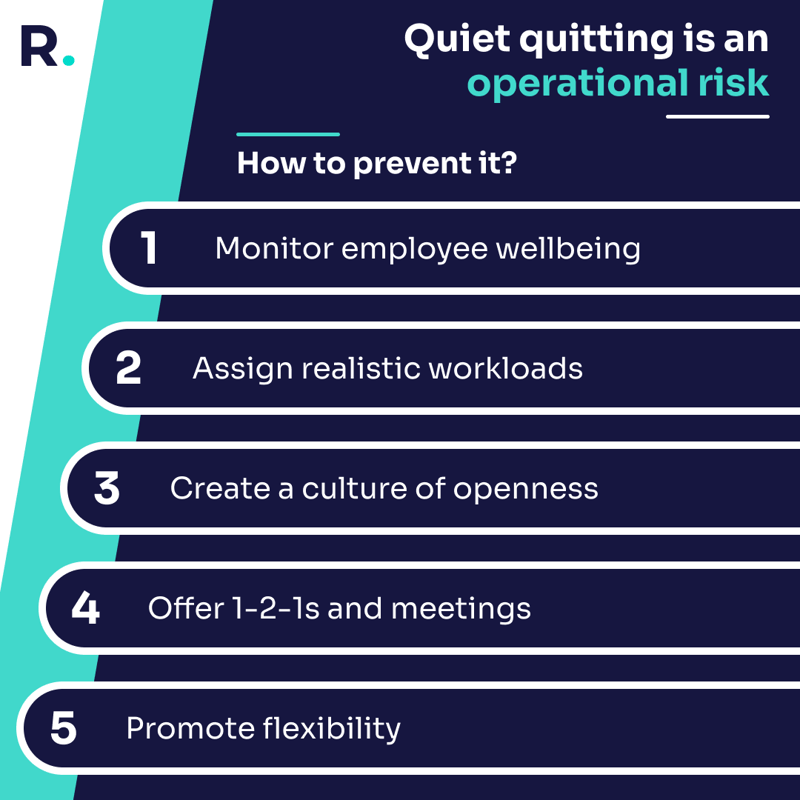TikTok and risk management don’t often go hand-in-hand (although maybe they should) - so you might find it hard to believe that one of today’s hottest GRC talking points gained traction there.
Don’t roll your eyes just yet, because quiet quitting could have huge implications for risk management.
In this blog, we explain what quiet quitting is, argue that it’s an operational risk, and provide some risk management-based solutions.
And remember, if you like what you see here, give our LinkedIn page a follow.
Let’s get started.
What is quiet quitting?
Quiet quitting is the act of doing what’s stated in your job description and nothing more. It’s therefore a rejection of hustle culture and an attempt to reclaim a healthy work-life balance.
In some ways, it’s an act of rebellion.
But not really the cool kind. You know, blasters, lightsabers.
In fact, it’s not really quitting at all. It’s simply unsubscribing from the expectations of going above and beyond, instead being content to deliver the bare minimum required to keep your employment.
Confused by the name? You wouldn’t be the only one. NPR’s audience offered up some more quirky alternatives like ‘acting your wage’, ‘reverse hustle’, and ‘workplace disassociation’. Catchy.
Is quiet quitting real?
This is where things start to get complicated.
The quiet quitting phenomenon has certainly proved to be divisive, with career coaches jumping at the opportunity to have their say. Others are less convinced.
One thing we can say for sure is that, unlike what many naysayers think, quiet quitting isn’t just a Gen Z thing.
It’s certainly easier to blame workplace woes on the youth of today, but the reality is that quiet quitting has always existed.
Gen Z have simply given the phenomenon a name, something they’re good at doing. We hate to say it, but any generational disapproval is misplaced.
You don’t have to look far for proof. Gallup’s State of the Global Workplace 2022 Report paints a bleak picture of job satisfaction and engagement, especially in Europe.
In this part of the world, a meagre 14% of employees are actively engaged in their work, with the following stats going some way to explaining why:
- 39% of workers report daily stress
- 37% of workers report daily worry
- 21% of workers report daily sadness
- 19% of workers report daily anger

It’s not just about cognitive engagement, either. Gallup further found that globally, 60% of people are emotionally detached from their work.
It’s also not healthy to expect workers to constantly do more than is written in their contracts. Superficial as they may be, job titles exist for a reason: to indicate the type of work you do, or are capable of doing.
Whether measures like a four-day working week would truly help is a discussion for another time, but by now you may be starting to see where risk management enters the conversation. More on that in a moment.
Can leadership be entirely blamed?
Okay, so let’s work on the basis that quiet quitting is a real thing, regardless of whether the name is simply putting some fancy new coating on an age-old concept.
The next logical question is this: who’s really at blame here?
Are team leaders failing to acknowledge the human aspect of the workplace? Are risk professionals focusing too much on strategic risk, compliance risk, and reputational damage? Are workers simply lazy?
Let’s look at it this way.
True: senior leadership is typically at the heart of quiet quitting.
False: employees can’t take any responsibility for their actions or behaviour at work.
The temptation is to see those who quiet quit as self-defeatists. In many instances, there’s sure to be truth in that.
By failing to take initiative, challenge oneself, or generally engage with work, quiet quitters are certainly limiting themselves.
It can be waving goodbye to any opportunities for professional development and can indicate a broader lack of discipline that can bleed into your personal life.
What are the implications of quiet quitting for risk management?
This is where the relationship between quiet quitting and risk management becomes clear.
The phenomenon of employees turning off from work – no matter how that ends up looking – could end up spelling disaster for any organisation.
Suddenly, ambition becomes ambivalence. Teamwork teeters. Colleagues clash.
Let’s remind ourselves how operational risk is defined.
Investopedia summarises it as the ‘uncertainties and hazards a company faces when it attempts to do its day-to-day business activities’, resulting from ‘breakdowns in internal procedures, people and systems’.
Typically, this refers to more overt issues with the workforce, such as fraud, lack of skills or qualifications, and general mistakes or errors that can prove to be costly.
But Investopedia also notes that you can boil operational risk down to the idea of ‘human risk’ – something that covers all bases when it comes to managing the risks of a workforce.
It’s not hard to see why quiet quitting is an operational risk when it can lead to the following:
- Decreased workplace morale
- Conflict between teams/departments
- Lowered output and weakened results
- A lack of critical thinking or initiative
- An emergence of mistakes or errors
- Bad mouthing a workplace, leading to reputational damage
What can risk managers do to prevent quiet quitting?
Risk professionals can’t take sole responsibility for company culture.
HR, for example, handles employee onboarding, perks, and generally shape the workplace experience.
Senior leadership set examples of openness and communication, often determining levels of comfort and professionalism.
Risk professionals, though, are responsible for helping to identify any risks associated with their workforce. This includes problems that can arise from disengaged staff, resignations, word-of-mouth reputation and more.
As Jennifer Geary notes in her new book ‘How to be a Chief Risk Officer’, “culture is the most powerful influencer of behaviour in the workplace and therefore must be considered first when it comes to risk”.
Here are some things that risk managers can champion (even if it comes down to another department to implement) in order to ensure a welcoming, productive culture – whether it’s virtual or in the office.

Keep an eye on employee wellbeing
The fact that risk management is a data-driven profession (or should be) shouldn’t overshadow the human element of the role.
You’re not a counsellor, remember, but being able to recognise the signs of burnout in your workforce is important.
This is especially hard when it comes to remote working, but software like CultureAmp can help out.
Here are a couple of key takeaways from Talkspace, too:
- Employees aged 18-34 are more likely to burn out
- 49% of workers said that having wellness days would help their stress levels
Not hard to see why this one is crucial.
Promote flexibility
Risk management may be more important than ever – but so is ensuring the best experience for your business’s workers. It’s an increasingly competitive landscape, after all.
As the UK faces a cost of living crisis and an impending recession, it’s vital that people are able to do what works best for them.
Forcing office work – especially when it isn’t obvious why, beyond the principle – in a post-2020 world is a surefire way to irk staff.
Yes, for some companies in-person work is a must. As long as your employees know what they’re signing up for, there’s no issue. But bringing back in-person work after years of flexibility needs to be communicated effectively.

Offer 1-2-1s and reviews
Sometimes the simplest solution is the best one.
Why not ask your staff how they’re doing?
Again, as a risk manager, this isn’t strictly within your remit. But chatting to line managers and ensuring that communication between upper and lower levels of a business is constant doesn’t have to be a big task.
If quiet quitting can be better thought of simply as coasting, then direct feedback is a no-brainer. Sorry (not sorry) to be hitting you with another statistic, but studies suggest that reduced professional accomplishments actually contribute more to burnout than exhaustion or cynicism.
It’s the same as any operational risk: you need to check in every now and then. Don’t assume that things will be fine just because they were last time.
Create a culture of openness
Culture isn’t about ping pong tables and beanbag chairs in the office. It’s about creating an environment where people feel safe and respected.
If workers feel like they have no one to turn to, there’s no chance they’ll still be giving it their all in a year’s time.
This is about transparency, too. Business developments both good and bad need to be communicated from the top.
Risk managers are likely aware of what can happen when rumours spread throughout the workforce, leading to low staff morale and widespread uncertainty.

Assign reasonable workloads
If quiet quitting is a rejection of hustle culture, then you need to ensure your workers are compensated properly.
Extra responsibilities can be fine. But if staff are being given tasks that fall outside their usual areas of expertise, you need to guarantee recognition, training opportunities, and even extra pay.
After all, to refer back to Talkspace, low pay is the number one cause of workplace stress.
What if risk professionals quiet quit?
Who watches the Watchmen, eh?
Risk professionals can end up phoning it in at work, too. They have a naturally high-pressure job, catalysed by clunky workflows and outdated processes.
In fact, since the pandemic, risk managers have faced high levels of burnout.
So when it comes to quiet quitting in the risk management department, what can be done?
The answer is simple – the same as above.
While risk management and HR teams are often the ones setting examples of – and policies for – workplace culture, it all applies to them, too. Reviews, clear paths to career progression, mental health resources, flexibility… all universal stuff.
Not only that, but software can help too. The parts of risk management that are dispiriting, tedious, or needlessly challenging can be streamlined through the help of a risk management platform.
Sick of spreadsheets? Bin them. Miffed with mistakes? Thing of the past.
RiskSmart is positioned to help SMEs achieve simple, data-driven risk management.
You can learn more about risk management software by clicking here.

October 24, 2023

Comments